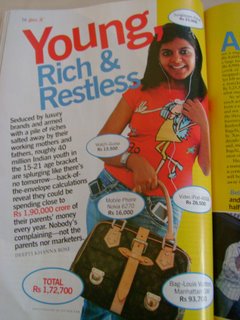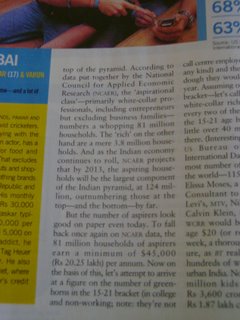 So far, so good. The example of one Ashima Bagchi (17), who's been photographed with her 60 gb video ipod (Rs 26,000), Nokia N 91 (Rs 35,000), Guess wallet (Rs 4600), Guess timepiece (Rs 16,000), Swarovski bracelet and ring (Rs 18, 900) is a bit over the top. (How wannabe is a 12,600 rupee Louis Vuitton ipod case??!) But such brats do exist.
So far, so good. The example of one Ashima Bagchi (17), who's been photographed with her 60 gb video ipod (Rs 26,000), Nokia N 91 (Rs 35,000), Guess wallet (Rs 4600), Guess timepiece (Rs 16,000), Swarovski bracelet and ring (Rs 18, 900) is a bit over the top. (How wannabe is a 12,600 rupee Louis Vuitton ipod case??!) But such brats do exist. And surely one can find a few hundred similar examples in our metros. Ok, even a few
thousand. What shook me out of bedside-reading-mode and made me switch on my computer was this startling conclusion by BT:
 "According to data put together by the National Council of Applied Economic Research
"According to data put together by the National Council of Applied Economic Research (NCAER), the 'aspirational class' - primarily white collar professionals including entrepreneurs but excluding business families - numbers a whopping 81 million households. The 'rich' on the other hand are a mere 3.8 million households...
The 81 million households of aspirers earn a minimum of $45,000 (Rs 20.25 lakhs) per annum... Assuming one child in this age bracket - let's call her and her ilk White Collar Richie Rich (WCRR) - in every two of these households is in the 15-21 age bracket, you have a little over 40 million of them out there."
Wow. 81 million households in India earning Rs 20 lakhs a year??? When did that miracle take place?
Either I'm Rip Van Winkle or ... someone has goofed up bigtime.
First of all, NCAER defines its income pyramid as 'rich', followed by 'middle class' and then come 'aspirers', lower down the ladder. So at the very least we should be looking at data for 'middle class'.
Middle class is defined by NCAER as households earning $4,400-$21,800 a year. ie Rs 2-10 lakhs a year.
The NCAER estimate for 'middle class' in 2001-2 was 10.7 million households (scroll to pg 7 & 8 of the pdf I have linked to). Their estimate for 'middle class' in 2005-6 is 16.4 million households. Which would translate to approximately 65-80 million people.
The 'aspirers' are defined by NCAER as households with an annual household income of between Rs 90,000 and Rs 2 lakh. The NCAER estimate for 'aspirer' households is 41.3 million households in 2001-2. And 53.3 million households in 2005-6.
For more details, check this pdf file on NCAER's website which encapsulates a report titled 'The Great Indian Market'. The report was published in association with Business Standard in August 2005.
So, what happened?
I can only conjecture that some error of multiplication is responsible for Business Today's erroneous conclusions. eg the income range of '90-200 may have been multiplied by annual household income in '000 to reach a figure of 2,000,000 (20 lakhs) instead of 200,000 (2 lakhs).
Or perhaps the $4,400 figure minimum used to include households in the 'middle class' class was misread as $44,000. Whatever it is, the stats used to support the basic hypothesis are way off the mark.
Surely an alarm bell should go off in someone's head when concluding that close to 45% of India's 188.2 million households are earning a minimum of Rs 20 lakhs ($45,000) a year. That is the kind of prosperity you fondly hope the country will achieve in your lifetime!
The reality is, 132 million households earning less than Rs 90,000 per annum. That's 70% of the India - classified by NCAER as the 'deprived'. Better things are predicted: NCAER believes that by 2009-10, the deprived class will shrink to 114 million households. But there's still a long way to go!
The truth is out there
Coming back to the 'WCRR'. I do see a trend in 'kids with too much money to spend' but clearly it's still a small trend. 'Guess' and 'Tommy Hilfiger' showrooms are deserted at most times. Yes, one comes across the types who will spend Rs 30,000 on a shopping spree at Mango. But they constitute a small rivulet, not a mighty rupee-swollen river.
Sadly, after reading BT's super-buoyant report, more luxury brands will set up shop in India. Waiting, like Godot, for the mythical '40 million' WCRRs to charge in with their credit cards!
Let me add, however, that the Indian youth market is a very attractive one. (I will attempt my own back of the envelope calculation one of these days!). But it's marketers who focus on novelty and quality at fair prices who will see far more success than the likes of Guess. At least in the short and medium run.
Of course, luxury brands do need to drop anchor here. But they'll need to be very patient!
It is a major bloomer. The article has gone overboard no doubt.
ReplyDeleteHey Rashmi,
ReplyDeleteHave you not seen those Richie Rich? Yhey are the major contributor to the "lifestyle" business. They are the frequent visitors of pubs durin "Happy Hours". They don't even think while swiping their credit cards. Thanks to the dual income of the parents, this syndrome will grow exponentially in years to come
Rashmi
ReplyDeleteI am actually surprised that you are blogging about bad reporting by otherwise established media houses - only now.
Few months ago - there was news item in ET
(http://economictimes.indiatimes.com/articleshow/msid-1672908,curpg-1.cms)
which talked about the salaries in IT... and it had similar preposterous numbers... which made out that the industry salary rate for a 5yr experience programmer was 25lakhs and at 10yrs experience was 1 crore.
And believe me - this caused a hell lot of confusion... and I am sure there are thousands of non-IT people which really believed the report too.
ET - went off with such BS as well... why not BT now...
Most of the stories on "trends" reported today in India are rarely well researched. They are usually hype.
ReplyDelete"Sadly, after reading BT's super-buoyant report, more luxury brands will set up shop in India. Waiting, like Godot, for the mythical '40 million' WCRRs to charge in with their credit cards!". Why sadly? if they are dumb enough to buy these figures they deserve a rude shock.
ReplyDeletevery interesting article...although the report is quite old to be taken seriously now.
ReplyDeleteAs a marketer I can vouch for the fact that research figures in India can be increasingly confusing...look at JuxtConsult's India Online 2008 report on ibef and you will notice some glaring inconsistencies when compared to TRAI or ITU data. But for all we know, all of them could be wrong.
As for the richie rich's, well with that kinda money, it will make more sense to shop in Singapore than in Delhi, considering it adds further to the snob factor...and the trip is hardly a bother money wise. For example, this person I know bought a Sony high-end handycam in SG purely because Sony India has a limited range & internationally outdated models on offer here..and is more expensive thanks to Indian taxes.
No wonder the stores are so deserted here!